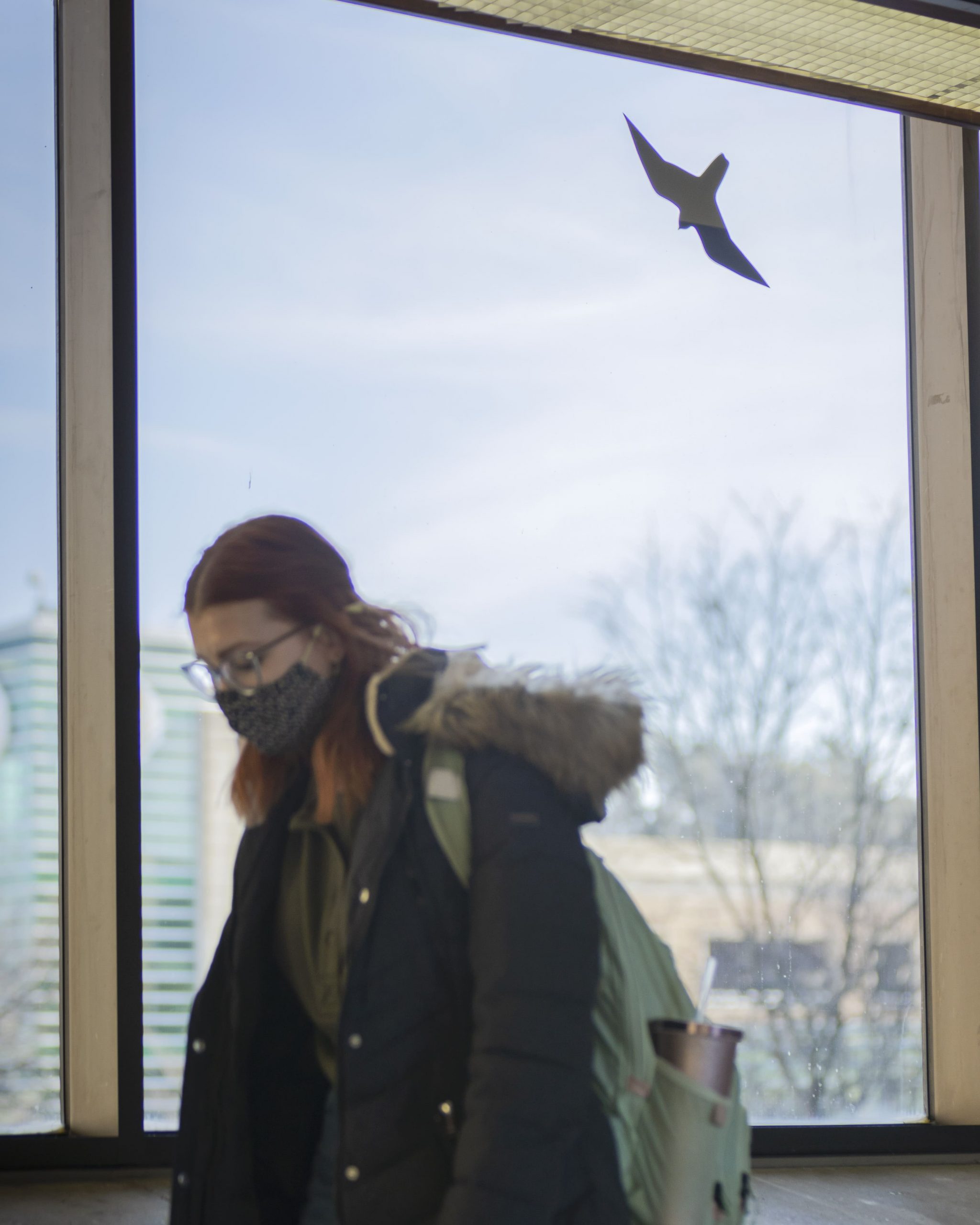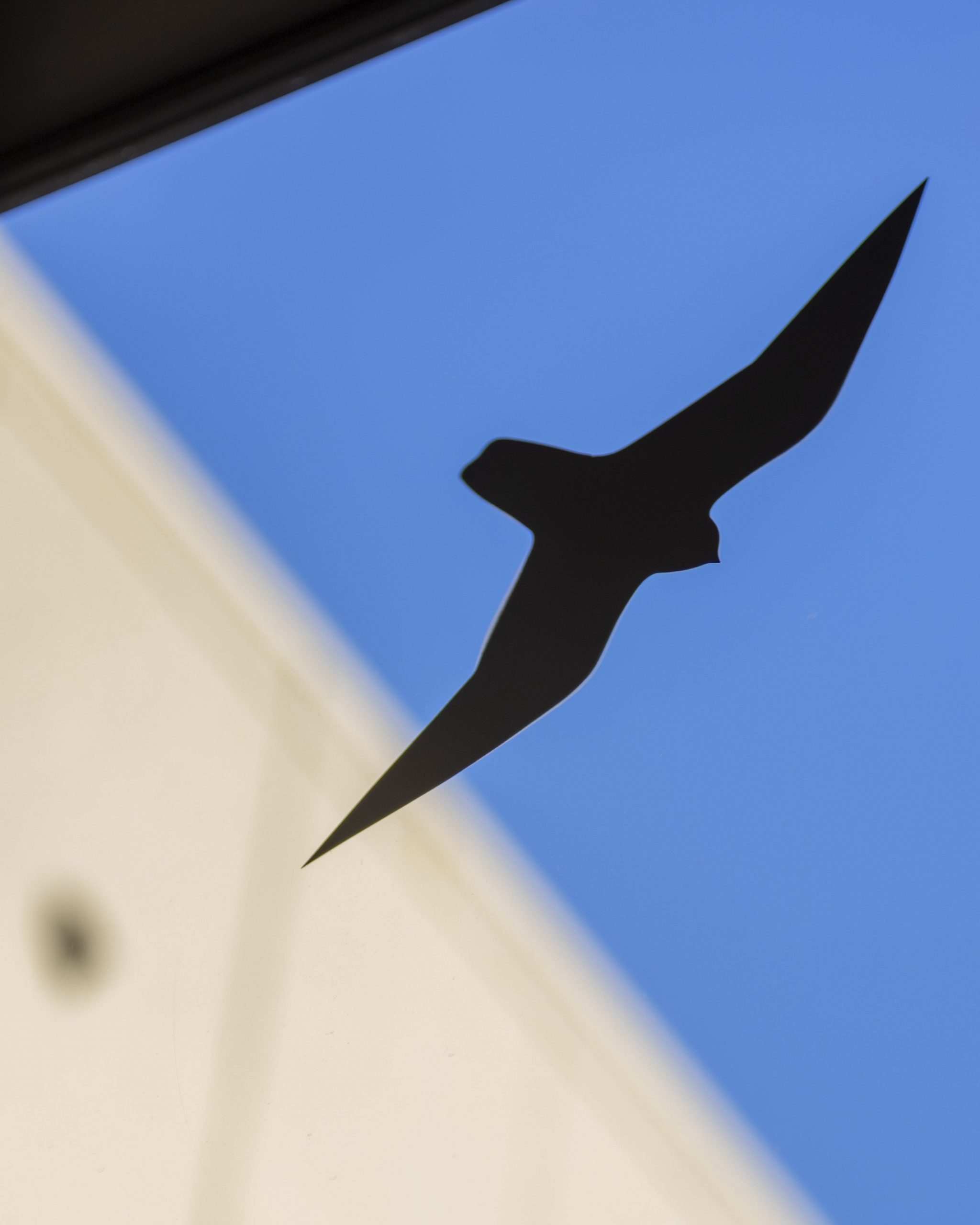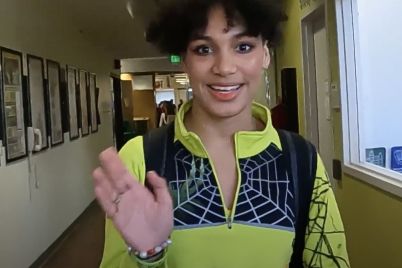
Students pass by window decals between the Crane Liberal Arts building and the Student Center. The reflectivity of windows confuses birds and can make a window look more like vegetation or sky than solid wall. Shelby Beaty | Washtenaw Voice
by RUBY GO
Staff Writer
It might be hard to imagine that something as commonplace as a window could be deadly. But for birds, window collisions almost always prove fatal.
“It’s exceptionally common,” said Heidi Trudell, coordinator of Washtenaw Safe Passage, a research branch of the Washtenaw Audubon Society that focuses on the collection of bird collision data. “Any bird that’s healthy enough to fly is at risk.”
As many as 1 billion birds die from colliding with windows each year — and that’s just in the U.S. About half of the birds will fly away with life threatening injuries, which means that well over a billion is likely a more accurate estimate. Window collisions are among the top human-related causes of bird deaths, together with cats and habitat destruction, all of which are contributing to roughly a 29% decline of bird species across North America. Here at WCC, one effort to mitigate the issue has missed the mark.

The bird decals were placed on the windows on the bridge between the Crane Liberal Arts building and Student Center. The decals have been there for about 15 years. Shelby Beaty | Washtenaw Voice
Ever notice the bird shaped stickers on some of the windows on campus? Those are actually more than just arbitrary decorations: They’re supposed to help prevent birds from flying into the windows. However, the stickers, properly known as bird or window decals, are proven to be rather ineffective unless they follow strict spacing guidelines.
“The fact that (the decals) are still sold is disappointing to me,” Trudell said.
In order for the window decals to work, they should be placed within two to four inches of each other, according to the National Audubon Society. If the gaps between the decals are larger than that, birds will still try to fly through the window, which means using the decals for larger windows is not a desirable choice.
“You’d have to put way too many of them (on the window) to the point where you couldn’t even see out of it,” Trudell said.
While there has not been thorough monitoring of bird deaths and collisions on campus, it is estimated that the number of dead birds found on campus each year is relatively small, according to Holly Herman, WCC landscape and grounds manager; dead deer are found on campus more often than dead birds, she said. However, some of the buildings on campus (and in the community) still pose a high risk to birds because of their large glass surface areas, among other factors. The front side of the Student Center is an example of a large glass surface area.
“Basically, (the birds) don’t understand glass. They just see what’s reflecting off of it,” said Grace Goetting, co-manager of the Bird Center of Michigan, a bird rehabilitation center in Washtenaw County. “If you’re (in a room) surrounded by trees and enjoying the view, that’s great for you, but all the birds are seeing is more stuff to fly through.”
At the bird rehab center, over 1,500 birds come in with injuries each year, Goetting said. Of those injuries, the majority of them are due to window collisions. Goetting says the rehab center often gets phone calls from people saying they saw an injured bird that already flew away; a common misconception is that if a bird flies away after hitting a window, then it must be OK, Goetting said.
However, just like with humans, birds get adrenaline rushes after they sustain an injury, which is what allows them to fly away. Once the adrenaline wears off, the bird’s condition likely deteriorates and it succumbs to its injuries.
“It’s really important that you don’t just let (an injured bird) fly away,” Goetting said. “Every injured bird should be sent to rehab.”
While any bird is at risk of a window collision, birds that produce flight calls during night time migration are more likely to collide with windows compared to birds that don’t produce flight calls, according to a 2019 study of 40 years of records of bird collisions in the Midwest. The flight calls are meant to help the birds’ decision making during migration, which is why the authors of the study speculate that flight-calling species may attract each other when disoriented by artificial light, thus causing higher mortality rates.
During night time migration, the authors of the study found that rates of the flight calls increased when birds flew over brightly lit areas (i.e., a city), which suggests that the light from illuminated buildings confuses the migrating birds. Birds navigate during migration partly through using Earth’s magnetic field, and scientists speculate that the “artificial light may disrupt a light-sensitive internal magnetic compass.”
Benjamin Winger, an evolutionary biologist at the University of Michigan was the lead author of the study. He was unable to participate in an interview due to other commitments.
OK. So what if birds are slowly dying out? Well, your caffeine fix might depend on it.
“Birds are really important in controlling certain pests,” Trudell said. “The more birds die, the more pesticides we drink.”
Birds eat one of the most harmful pests on coffee farms across the world, the coffee borer beetle, which is otherwise killed off with pesticides. In Brazil alone, the beetles can cause up to $300 million worth of losses, according to National Geographic.
Just one bird can save up to 65 pounds worth of coffee per hectare on a farm every year, according to a study published by the journal Ecological Economics. What’s more, farmers can increase their income by more than 30% by changing some of their coffee plantings to be shade grown, which is the best environment for the beetle-eating birds.
“You’d be surprised at how much birds actually help us,” Trudell said.
How to help
Both Trudell and Goetting emphasize the importance of sending injured birds to a local wildlife rehabilitation facility. If you find an injured bird and want to bring it into a rehab facility, it’s important to contact the facility beforehand. A list of rehabilitators throughout Michigan can be found here.
If you’re interested in helping to reduce the bird collision issue, the National Audubon Society recommends the following:
- Make windows “bird friendly” with designs created with window markers or paints. They should not have gaps greater than two to four inches. The same rule applies to window decals.
- Install external screens on windows
- Close window drapes or blinds at night when artificial lights are on
- Keep indoor plants away from windows

